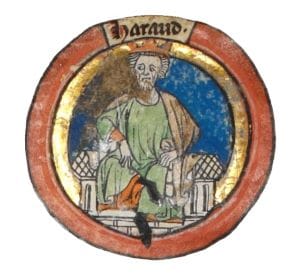Consecration Lecture – Harold Godwinson Court No. 99

Harold Godwinson, better known to us all as King Harold II, the last Saxon King
Harold Godwinson, born circa 1022 died at the Battle of Hastings on 14 October 1066, was also called Harold II and was the last crowned Anglo-Saxon English King.
Harold reigned from 6 January 1066 until his death at the Battle of Hastings on 14 October 1066, just 10 months after claiming the Crown, at the decisive battle of the Norman Conquest. Harold’s death marked the end of Anglo-Saxon rule over England, being succeeded by William the Conqueror. Just prior to the Battle of Hasting in late September, he successfully repelled an invasion by a rival claimant to the Crown, Harald Hardrada of Norway, in York before marching his army back south to meet William at Hastings just two weeks later; a major feat to march an Army weary from battle to the very south of England.
So who was Harold Godwinson? And how did he succeed to the throne of England and thus became the last Saxon King.
Harold Godwinson was a member of a prominent Anglo-Saxon family with ties to King Canute. He became a powerful Earl of Wessex after the death of his own father, Godwin, the former Earl of Wessex. Harold’s mother, Gytha, belonged to a powerful Danish noble family with close connections to Canute, the Danish King of England.
Harold Godwinson’s father Godwin survived and remained in power during a period of political unrest on who would succeed to the English, throne by switching sides on numerous occasions and being involved in the murder in 1036 of Alfred Aetheling, half-brother of Hartha Canute who was crowned in 1040 and younger brother of the later King Edward the Confessor.
Godwin survived due to an oath and a large gift secured the new king’ as favour. Godwin’s daughter (Harold’s sister) Edith married Edward the Confessor 3 years into his reign which lasted from 1042 to 1066.
Godwin emerged as the dominant figure in the Kingdom early in Edward’s reign, more powerful even than the King himself. About 1044, Godwin obtained for Harold Godwinson the Earldom of East Anglia, Essex, Cambridgeshire, and Huntingdonshire. However following a disagreement with the King and unsuccessful rebellion, Godwin and his sons were banished for defying royal authority and King Edward sent his wife Edith to a convent and designated William of Normandy as his heir.
In 1052 Harold Godwinson invaded England and forced King Edward to restore his father and his family to their previous positions. Godwin’s restoration was short-lived; he died in 1053. Harold’s older brother Sweyn had died on a pilgrimage the previous year, and thus he succeeded to his father’s Earldoms, becoming (as his father had been) the dominant figure in the English kingdom. His hand was further strengthened in the 1050s by the deaths of the Earl of Mercia and other rivals and by 1057 Harold had obtained Earldoms for his three brothers.
Harold, who cultivated good relations with the leading clerics of the Kingdom, including Stigand, the Bishop of Winchester and the Archbishop of Canterbury, was an active patron of various religious houses, most notably the College of Canons at Waltham.
It was not all fair sailing for Harold, facing opposition from Mercia & Northumberland. However, again Harold turned this into his advantage and he strengthened his position with the Mercians and the Welsh by marrying Morcar’s[1] sister, who had previously been married to a Welsh Prince.
Having established himself as the preeminent figure in England by the mid-1060s, Harold most likely expected to ascend the throne after the passing of the childless King Edward. His designs, however, were complicated by events in 1064 leading to the invasion of William of Normandy and Edwards previous designation as naming William his Heir.
Despite Edward’s promise of the throne to William, Edward from his deathbed designated Harold his heir. On Edward’s, his brother-in-law’s death on January 5th 1066, the Witenagemot (the English nobility) convened and chose Harold to succeed Edward and on January 6th he was crowned and anointed King at Westminster Abbey by the Archbishop of York. Harold was probably the first English monarch to be crowned in Westminster Abbey.
Harold’s reign, however, was destined to be short and troubled. He was immediately threatened by William and Harald III Hardraade, King of Norway which eventually led to him fighting his battle in the North at Stanford Bridge where he killed Harald on September 25th before marching south to his battle at Hastings where he was killed on October 14th.
History is written by the victor. The manner of Harold’s legendary death, an arrow in the eye, in the medieval view was the proper fate of perjurers. It is unclear whether Harold really died in this way, however; indeed, legends from the 12th century maintain that he was not killed at Hastings. According to one such tale, Harold spent two years recovering from wounds he received at Hastings before going on a pilgrimage in France and England. According to that tale he returned as an old man and lived as a hermit at Dover and Chester where he revealed his true identity just before dying.
It can be said despite Harold Godwinson’s brief reign as King, Harold was a key figure in English history and a talented leader in peace and war.
[1] Son of the Earl of Mercia and later Earl of Northumbria by the time of the Battle of Hastings.
W & Em Bro Peter Hartland KAG PJGD
Provincial Eminent Grand Prior
November 2024